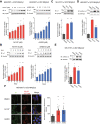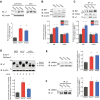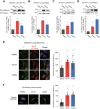Pharmacological activation of ATF6 remodels the proteostasis network to rescue pathogenic GABAA receptors
- PMID: 35477478
- PMCID: PMC9044816
- DOI: 10.1186/s13578-022-00783-w
Pharmacological activation of ATF6 remodels the proteostasis network to rescue pathogenic GABAA receptors
Abstract
Background: Genetic variants in the subunits of the gamma-aminobutyric acid type A (GABAA) receptors are implicated in the onset of multiple pathologic conditions including genetic epilepsy. Previous work showed that pathogenic GABAA subunits promote misfolding and inefficient assembly of the GABAA receptors, limiting receptor expression and activity at the plasma membrane. However, GABAA receptors containing variant subunits can retain activity, indicating that enhancing the folding, assembly, and trafficking of these variant receptors offers a potential opportunity to mitigate pathology associated with genetic epilepsy.
Results: Here, we demonstrate that pharmacologically enhancing endoplasmic reticulum (ER) proteostasis using small molecule activators of the ATF6 (Activating Transcription Factor 6) signaling arm of the unfolded protein response (UPR) increases the assembly, trafficking, and surface expression of variant GABAA receptors. These improvements are attributed to ATF6-dependent remodeling of the ER proteostasis environment, which increases protein levels of pro-folding ER proteostasis factors including the ER chaperone BiP (Immunoglobulin Binding Protein) and trafficking receptors, such as LMAN1 (Lectin Mannose-Binding 1) and enhances their interactions with GABAA receptors. Importantly, we further show that pharmacologic ATF6 activators increase the activity of GABAA receptors at the cell surface, revealing the potential for this strategy to restore receptor activity to levels that could mitigate disease pathogenesis.
Conclusions: These results indicate that pharmacologic ATF6 activators offer an opportunity to restore GABAA receptor activity in diseases including genetic epilepsy and point to the potential for similar pharmacologic enhancement of ER proteostasis to improve trafficking of other disease-associated variant ion channels implicated in etiologically-diverse diseases.
© 2022. The Author(s).
Conflict of interest statement
RLW and JWK are inventors on patents describing ATF6 activator compounds, including AA147 and AA263. RLW and JWK are also shareholders and scientific advisory board members of Protego Biopharma who have licensed the ATF6 activators AA147 and AA263.
Figures







Similar articles
-
Remodeling the endoplasmic reticulum proteostasis network restores proteostasis of pathogenic GABAA receptors.PLoS One. 2018 Nov 27;13(11):e0207948. doi: 10.1371/journal.pone.0207948. eCollection 2018. PLoS One. 2018. PMID: 30481215 Free PMC article.
-
Phenylhydrazone-based Endoplasmic Reticulum Proteostasis Regulator Compounds with Enhanced Biological Activity.bioRxiv [Preprint]. 2025 Apr 5:2025.04.04.646800. doi: 10.1101/2025.04.04.646800. bioRxiv. 2025. PMID: 40236048 Free PMC article. Preprint.
-
Proteostasis Regulators Restore Function of Epilepsy-Associated GABAA Receptors.Cell Chem Biol. 2021 Jan 21;28(1):46-59.e7. doi: 10.1016/j.chembiol.2020.08.012. Epub 2020 Sep 3. Cell Chem Biol. 2021. PMID: 32888501 Free PMC article.
-
ATF6 as a Nodal Regulator of Proteostasis in the Heart.Front Physiol. 2020 Apr 8;11:267. doi: 10.3389/fphys.2020.00267. eCollection 2020. Front Physiol. 2020. PMID: 32322217 Free PMC article. Review.
-
Proteostasis regulation of GABAA receptors in neuronal function and disease.Biomed Pharmacother. 2025 May;186:117992. doi: 10.1016/j.biopha.2025.117992. Epub 2025 Mar 20. Biomed Pharmacother. 2025. PMID: 40112516 Free PMC article. Review.
Cited by
-
Divergent Proteome Reactivity Influences Arm-Selective Activation of Pharmacological Endoplasmic Reticulum Proteostasis Regulators.bioRxiv [Preprint]. 2023 Jan 17:2023.01.16.524237. doi: 10.1101/2023.01.16.524237. bioRxiv. 2023. Update in: ACS Chem Biol. 2023 Aug 18;18(8):1719-1729. doi: 10.1021/acschembio.3c00042. PMID: 36712115 Free PMC article. Updated. Preprint.
-
Pervasive mislocalization of pathogenic coding variants underlying human disorders.Cell. 2024 Nov 14;187(23):6725-6741.e13. doi: 10.1016/j.cell.2024.09.003. Epub 2024 Sep 30. Cell. 2024. PMID: 39353438
-
The endoplasmic reticulum membrane complex promotes proteostasis of GABAA receptors.iScience. 2022 Jul 13;25(8):104754. doi: 10.1016/j.isci.2022.104754. eCollection 2022 Aug 19. iScience. 2022. PMID: 35938049 Free PMC article.
-
Hsp47 promotes biogenesis of multi-subunit neuroreceptors in the endoplasmic reticulum.Elife. 2024 Jul 4;13:e84798. doi: 10.7554/eLife.84798. Elife. 2024. PMID: 38963323 Free PMC article.
-
Protein quality control of N-methyl-D-aspartate receptors.Front Cell Neurosci. 2022 Jul 22;16:907560. doi: 10.3389/fncel.2022.907560. eCollection 2022. Front Cell Neurosci. 2022. PMID: 35936491 Free PMC article. Review.
References
-
- X. Fu, Y. J. Wang, J. Q. Kang and T. W. Mu GABAA Receptor Variants in Epilepsy, In: Czuczwar SJ, editor. Epilepsy. Brisbane (AU): Exon Publications. Doi: 10.36255/exon-publications-epilepsy-gaba-receptor - PubMed
Grants and funding
LinkOut - more resources
Full Text Sources

